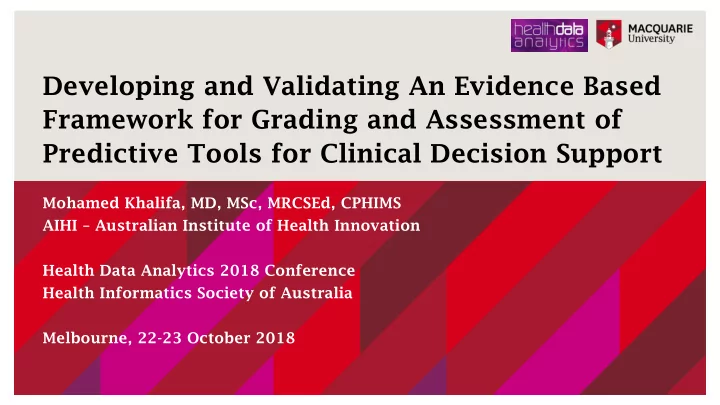

Developing and Validating An Evidence Based Framework for Grading and Assessment of Predictive Tools for Clinical Decision Support Mohamed Khalifa, MD, MSc, MRCSEd, CPHIMS AIHI – Australian Institute of Health Innovation Health Data Analytics 2018 Conference Health Informatics Society of Australia Melbourne, 22-23 October 2018
Background Clinical decision support (CDS) systems improve healthcare cost- effectiveness through enhancing evidence-based practice. Among CDS are the clinical predictive tools, which quantify contributions of relevant patient characteristics to derive likelihood of diseases or predict clinical outcomes. Clinicians are challenged when choosing among a growing number of tools, most of which have never been implemented or assessed for comparative performance or impact. Centre for Health Informatics | Australian Institute of Health Innovation | Faculty of Medicine and Health Sciences 2
Aim and Objectives The aim is to develop and validate a framework to Grade and Assess Predictive tools (Abbreviated as GRASP). The objective it to provide clinicians with a standardised, evidence-based grading system to support their search for and selection of best clinical predictive tools for their tasks. The GRASP framework is based on the critical appraisal of published evidence about the performance, potential effect, usability, and impact of predictive tools. Centre for Health Informatics | Australian Institute of Health Innovation | Faculty of Medicine and Health Sciences 3
Study 1 – Developing the GRASP To develop the framework; a focused review of the literature was conducted to extract criteria to evaluate predictive tools. An initial framework was designed and applied to assess and grade five predictive tools: LACE Index, Centor Score, Well’s Criteria, the Modified Early Warning Score, and Ottawa knee rule. After peer review, the GRASP framework was revised and the grading of the five tools was updated. Centre for Health Informatics | Australian Institute of Health Innovation | Faculty of Medicine and Health Sciences 4
Results The GRASP framework grades predictive tools based on published evidence across three dimensions: 1) Phase of evaluation (before, during and after implementation) 2) Level of evidence (assigning a numerical score) 3) Direction of evidence (positive, negative or mixed) The final grade of a tool is based on the highest phase of evaluation, supported by the highest level of positive evidence, or mixed evidence that supports a positive conclusion. Centre for Health Informatics | Australian Institute of Health Innovation | Faculty of Medicine and Health Sciences 5
Assigned Direction of GRASP Framework – Grading and Grades Evidence Assessment of Predictive Tools for Clinical Decision Support Clinical Effectiveness, Positive Level of Patient Safety or Evidence Negative Healthcare Efficiency Phase of Evaluation Mixed supporting positive conclusion Experimental studies A1 Mixed supporting negative conclusion Phase A: Post Implementation Observational studies A2 Impact Based on subjective studies A3 Reported usability testing B1 Phase B: During Implementation Estimated potential effect on healthcare B2 C1 Tested for external validity multiple times Phase C: Pre C2 Implementation Tested for external validity only once Performance C3 The predictive tool has been tested for internal validity Centre for Health Informatics | Australian Institute of Health Innovation | Faculty of Medicine and Health Sciences 6
GRASP Framework Report Tool Information Grade C Criteria Grade B Criteria Grade A Criteria Assigned Grade Direction of Evidence Detailed Evidence Centre for Health Informatics | Australian Institute of Health Innovation | Faculty of Medicine and Health Sciences 7
Centre for Health Informatics | Australian Institute of Health Innovation | Faculty of Medicine and Health Sciences 8
Study 2 – Expert User Validation The study examines the content validity as well as the inter-rater reliability of GRASP framework. For content validity, expert users complete an online survey on the criteria used to grade predictive tools. For the inter-rater reliability, expert researchers grade eight predictive tools using GRASP and published studies on the tools. Levels of agreements and consensus will be evaluated as well as feedback suggestions on adding, changing or removing criteria. Centre for Health Informatics | Australian Institute of Health Innovation | Faculty of Medicine and Health Sciences 9
Study 3 – End User Validation The study examines the impact of using GRASP on improving the decisions made by end user clinicians regarding predictive tools. A group of emergency department clinicians are requested to answer critical questions about clinical predictive tools, with and without using the GRASP framework reports. The levels of efficiency, consistency, and accuracy are measured comparing the results of the two scenarios. Centre for Health Informatics | Australian Institute of Health Innovation | Faculty of Medicine and Health Sciences 10
Study 4 – Applying the Framework Using GRASP, all available 14 paediatrics head injury predictive tools used at the emergency department are graded based on the critical appraisal of their published evidence. The study will discuss: the correlation between tools assigned grades and their country, year of development, number of citations, studies, patient sample size, number of authors, and support by dedicated and well-funded research networks, programs, and professional groups or their appearance on clinical guidelines or endorsement by professional organisations. Centre for Health Informatics | Australian Institute of Health Innovation | Faculty of Medicine and Health Sciences 11
Centre for Health Informatics | Australian Institute of Health Innovation | Faculty of Medicine and Health Sciences 12
Study 4 – Conclusions All the tools used the same development methodologies and almost the same clinical variables. However, they showed variable predictive performances, which were not correlated with their assigned grades. The quality of tools’ development studies, the experience and credibility of their authors, and the support by dedicated and well- funded research programs were more significantly influential, than the predictive performance, on the acceptance and successful implementation of tools Centre for Health Informatics | Australian Institute of Health Innovation | Faculty of Medicine and Health Sciences 13
Thank You Centre for Health Informatics | Australian Institute of Health Innovation | Faculty of Medicine and Health Sciences 14
Recommend
More recommend